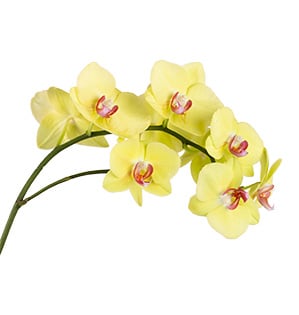Phalaenopsis Orchid

Common Names: Moth orchid, Butterfly orchid, Moon orchid, Phal Orchid, Phal.
Botanical names: Phalaenopsis spp.
Availability: Year round
Vase life: A ver long lasting orchid. A freshly cut spike of blossoms can last 7 to 21 days
Storage temperatures: 55 - 60 degrees Fahrenheit
Ethylene Sensitive: Yes
Description: The Phalaenopsis orchid is known as the moth orchid because of the blossom's resemblance to a moth. The blossom has five petals and sepals arranged in a symmetrical fashion. These petals are often broad and somewhat oval-shaped, with gently undulating edges. The distinctive lip, or labellum, is a defining feature of Phalaenopsis orchids. It serves as a landing platform for pollinators and often has a striking coloration or pattern to attract them. The lip may be larger and more prominent than the other petals, with a unique shape that varies between species and hybrids.
Color: Various shades of white, pink, purple, yellow, and green. Some flowers exhibit solid colors, while others display intricate patterns such as spots, stripes, or gradients.
Botanical facts: The natural habitat of Phalaenopsis orchids includes tropical and subtropical regions of Southeast Asia, such as the Philippines, Indonesia, Taiwan, and parts of Australia. They typically grow in humid forests, often at elevations ranging from sea level to higher mountain regions.
Design notes: The long gracefully curving spikes of the Phalaenopsis orchid add a beautiful draping line to arrangements and bouquets. Many designers purchase potted Phalaenopsis orchid plants, then cut the spikes for designing.
Purchasing hints: Select healthy stems with vibrant flowers. Avoid translucent or blemished blossoms.
Conditioning: Cut the stem ends with a sharp knife. Hydrate in a solution of water and commercial floral food for two hours before storage or usage.
Additional notes: In their natural habitat, Phalaenopsis orchids are primarily pollinated by moths and butterflies, which are attracted to their fragrant flowers. The flowers produce nectar to entice these pollinators, and the shape and coloration of the lip help guide them towards the reproductive structures of the flower.

